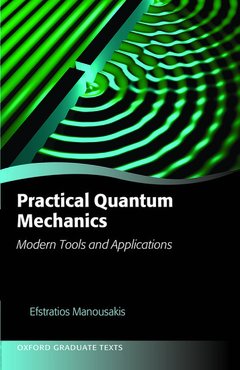Description
Practical Quantum Mechanics
Modern Tools and Applications
Oxford Graduate Texts Series
Author: Manousakis Efstratios
Language: English
Publication date: 11-2015
350 p. · 18.6x24.8 cm · Hardback
350 p. · 18.6x24.8 cm · Hardback
Description
/li>Biography
/li>
Quantum mechanics forms the foundation of all modern physics, including atomic, nuclear, and molecular physics, the physics of the elementary particles, condensed matter physics. Modern astrophysics also relies heavily on quantum mechanics. Quantum theory is needed to understand the basis for new materials, new devices, the nature of light coming from stars, the laws which govern the atomic nucleus, and the physics of biological systems. As a result the subject of this book is a required course for most physics graduate students. While there are many books on the subject, this book targets specifically graduate students and it is written with modern advances in various fields in mind. Many examples treated in the various chapters as well as the emphasis of the presentation in the book are designed from the perspective of such problems. For example, the book begins by putting the Schrödinger equation on a spatial discrete lattice and the continuum limit is also discussed, inspired by Hamiltonian lattice gauge theories. The latter and advances in quantum simulations motivated the inclusion of the path integral formulation. This formulation is applied to the imaginary-time evolution operator to project the exact ground state of the harmonic oscillator as is done in quantum simulations. As an example of how to take advantage of symmetry in quantum mechanics, one-dimensional periodic potentials are discussed, inspired by condensed matter physics. Atoms and molecules are discussed within mean-field like treatment (Hartree-Fock) and how to go beyond it. Motivated by the recent intense activity in condensed matter and atomic physics to study the Hubbard model, the electron correlations in the hydrogen molecule are taken into account by solving the two-site Hubbard model analytically. Using the canonical Hamiltonian quantization of quantum electrodynamics, the photons emerge as the quanta of the normal modes, in the same way as the phonons emerge in the treatment of the normal modes of the coupled array of atoms. This is used later to treat the interaction of radiation with atomic matter.
Efstratios Manousakis received his Ph. D. in Theoretical Physics, in 1985, from the University of Illinois at Urbana-Champaign. After a Post-Doctoral Research position at the Center for Theoretical Physics at the Massachusetts Institute of Technology (1985-1987) and at the Supercomputer Computational Research Institute (1987-88), he joined the Florida State University physics faculty, where he is the Donald Robson Professor of Physics and holds the title of Distinguished Research Professor.
© 2024 LAVOISIER S.A.S.




